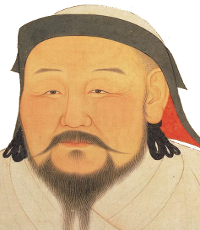From Temüjin to Genghis Khan
The boy who was to become Genghis Khan was born in 1162, not far from the current Mongolian capital of Ulaanbaatar. He was given the name Temüjin. Like all Mongolian boys, Temüjin learned to ride a horse at a very early age, to tend the family’s animals and to hunt. His father was a chieftain, and well respected within the society of nomads, but there were many chieftains on the steppes. Indeed, the people we call the Mongols were only one of many nomadic tribes — in addition, there were Merkits, Naimans, Keraits, Tatars, Uyghurs, and so on — and the Mongols were not even the largest group among them. Each tribe was divided into clans and lineages, and many of them were in perpetual conflict with each other — over grazing rights, horses and treasure. They traded with each other, but they also raided each other’s camps looking for women to take as wives or for children to capture and keep as slaves. Indeed kidnapping was a common way to obtain a wife, especially for those who were too poor to be considered eligible husbands.
Then disaster struck. Temüjin’s father was killed and the family was cast out by their clan who decided that they did not have enough food to feed them. Instead, at the age of only eight, Temüjin had to help his family eke out a living gathering plants on the steppe and hunting in the forest. Remarkably the family survived, although their camp was raided and Temüjin was taken prisoner and made into a slave. At the age of seventeen, he managed to escape his captors and marry a girl, Börte, to whom he had been engaged already while his father was alive. Yet Börte too was abducted by a rivaling tribe. This event, however, was to be the beginning ofTemüjin’s career as a conqueror. Together with a small band of followers, he attacked the kidnappers and took back his wife. He meted out an act of terrible revenge on her captors — killing the men and enslaving their women and children.
Temüjin’s skills as a raider soon attracted wider attention and before long he concluded a treaty with one of the traditional chieftains which gave him access to a far larger contingent of men. This was the band of warriors which he went on to leverage into an ever-increasing force as every successful raid attracted ever more of a following. The people who were loyal to him he treated as family members, while those who crossed or betrayed him were given no mercy. In 1206, Temüjin called a kurultai, an assembly of the leading chieftains, where he was elected khagan, khan of khans. He took the name “Genghis Khan” for himself. There is no consensus on what “genghis” actually means and in any case the pronunciation in Mongolian is closer to “chinggis.” The people he united came to be called “Mongols” after the name of his own tribe. Genghis Khan was now the supreme leader of perhaps 1 million people and some 15 to 20 million horses, sheep, and goats.



